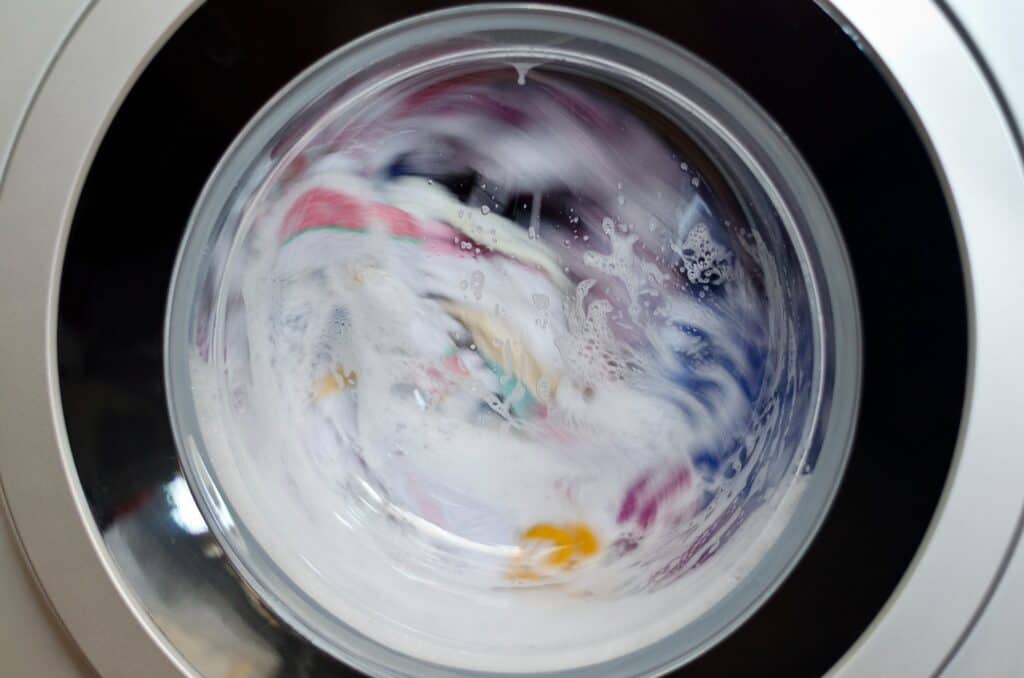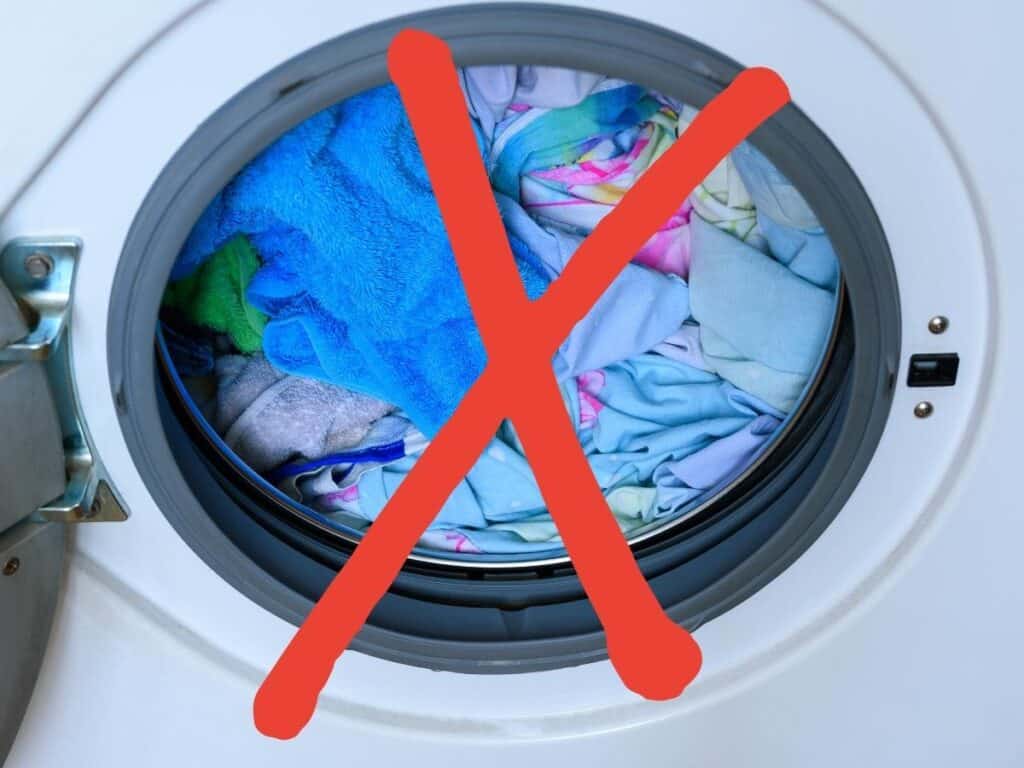Your washer, much like every other appliance in your home, has its limits. There’s a maximum capacity, minimum capacity, and then there’s the sweet spot.
The capacity of the washer refers to how many clothes you can put in the tub in a single load without impacting the washing quality or performance. The following chart illustrates this perfectly.
| Washer Capacity | Number and Type of Clothes |
| 5 KG (small) | 12 T-shirts, or 3 shirts and one pair of pants, or 6 towels |
| 5.5 KG (small) | 16 T-shirts, or 4 shirts and one pair of pants, or 8 towels |
| 6 KG (small) | 20 T-shirts, or 5 shirts and two pairs of pants, or 10 towels |
| 6.5 KG (Medium) | 24 T-shirts, or 6 shirts and two pairs of pants, or 12 towels |
| 7 KG (Medium) | 28 T-shirts, or 7 shirts and three pairs of pants, or one double duvet |
| 8 KG (Medium) | 32 T-shirts, or 8 shirts and three pairs of jeans, or 2 bedsheets and 4 towels |
| 10 KG (Large) | 40 T-shirts, or 5 shirts and two pairs of jeans and two towels, or 3 bedsheets, 3 towels, and 6 pillowcases |
| 12 KG (Extra Large) | 50 T-shirts, or 7 shirts, 3 pairs of jeans and 3 towels, or 5 bedsheets, 4 towels, and 8 pillowcases |
So what’s the deal with the kilograms when measuring the washer’s capacity? And can you measure the volume or capacity of the washer tub in cubic feet? Read more to find answers to all of these questions.
Load Sizes Explained
Load sizes come in three categories: medium, large, and extra large. There’s nothing called a small load. If it’s just one or two small items of clothing, then you should wait until you have a full laundry load that fits between your arms.
As you well know, using terms like medium and large is relatively subjective. What’s large for one person is medium for the next person. Let’s take a deeper look at each load size to simplify things for you and help you get your head around the load sizes.
- Medium Load: When we say this is a medium load, we usually expect it to be around 6 pounds in weight, and you can scoop it easily with your arms. It should fill your arms comfortably with some room for a few more items.
- Large Load: A large load weighs approximately 11 pounds. You can barely get your arms around the whole load. That’s a load worthy of a large washer.
- Extra Large Load: This load weighs about 21 pounds, and you can’t scoop it up in your arms and take it to the extra large washer. Most likely, you’ll load it in the car and take it to a laundromat, where they would have extra large washers for this type of load.
How to Calculate the Tub Capacity of a Washer

If there’s one thing that sticks out to you from the above chart, it must be the way washer capacity is classified by kilograms. But it’s pretty apparent that kilograms don’t exist in the imperial system. So how are you supposed to understand that?
There’s one way to calculate the tub volume of your washer without having to study the metric system from scratch.
To do that, you’ll need a measuring tape, pen and paper, and the calculator app on your phone. Then follow these steps.
- Use the foot side of the measuring tape to get all your measurements in feet.
- Measure the diameter of the tub from one side to the opposite side.
- Divide the diameter by two to get the radius (R). Set down that number.
- Measure the depth (D) of the tub from the edge to the bottom in feet. Write down that number.
- Now you need to use this formula: Pi x R x R x D, where Pi = 3.14, R is the radius, and D is the depth of the tub.
- Keep in mind that you’re multiplying the radius by itself and not multiplying it by two.
- The number you get is the volume of your washer in cubic feet.
Now that you know the capacity of your washer in cubic feet use the following table to help you determine the proper load size for your washer in pounds.
| Tub Volume in Cubic Feet | Ideal Load Size in Pounds |
| 1.5 to 3.4 (small) | 4 to 8 |
| 3.5 to 4.4 (medium) | 12 to 16 |
| 4.5 to 5.0 (large) | 16 to 20 |
| 5.1 to 6.2 (extra large) | 20 to 25 |
How Many Clothes You Can Put in Washing Machines

OK, we know what load sizes are there, but what about the number and types of clothes you can load into the tub? That question requires a detailed answer.
To explain the number of clothes you can add to a single laundry load, we’ll need to break down the washers by tub volume or capacity.
I’ll be using the kilogram unit to measure the capacity of the washer. For your reference, one kilogram = 2.2 pounds. So it’s easy to convert back and forth in your head.
5 KG Washer
A 5-kg washer is a small and compact machine for a small family of one adult and a baby. This washer takes the smallest load possible. To avoid overloading such a small washer with its small tub, use the smallest medium load possible.
You should limit each single load to 12 T-shirts, or 3 shirts and one pair of pants, or 6 medium-size towels.
5.5 KG Washer
Slightly larger than the previous washer but is still considered a small machine. A single load would be limited to 16 T-shirts, or 4 shirts and one pair of pants, or 8 towels. The towels are all medium-size. If you have one large towel in the midst, take out a single medium size towel from the load to compensate.
6 KG Washer
Although still a small machine, the 6-kg washer can accommodate two adults easily. It takes a slightly larger load than the two previous machines. But you can’t go overboard with this one. Such machines have limited features in general.
The laundry load should contain 20 T-shirts, or 5 shirts and two pairs of pants, or 10 towels. I wouldn’t recommend washing 10 towels at once, though.
6.5 KG Washer
Now we’re entering the medium washer category. A 6.5-kg tub is a decent size for a family of two adults and 2 children. You’ll have more settings on this washer than on all the smaller washers before. This translates into large laundry loads and more variety.
A single load can have 24 T-shirts, or 6 shirts and two pairs of pants, or 12 towels. The pants can be denim as well.
7 KG Washer
Most washers belong to this category. This is a good enough tub volume to handle the laundry needs of a family of 4 to 6 people. You can wash bed sheets, jeans, and other heavy clothes without a problem in this washer.
You can load it with 28 T-shirts, or 7 shirts and three pairs of pants, or one double duvet. Replace the double duvet with a quilt or a blanket.
8 KG Washer
While still a medium washer, the 8-kg machine is a powerful one with lots of programs to handle all types of clothes. The chances of overloading an 8-kg washer are minimal. Still, you should confine each laundry load to one of the following:
- 32 T-shirts, or
- 8 shirts and three pairs of jeans, or
- 2 bedsheets and 4 towels
You can replace the 2 bedsheets with a single blanket or a quilt.
10 KG Washer
The 10-kg washer is a category of its own. It’s a large machine with exceptionally varied settings and powerful features. You only need one of those monsters when you have a large family of 8 or more members.
A single laundry load can contain something like 40 T-shirts, or 5 shirts, two pairs of jeans and two towels, or 3 bedsheets, 3 towels, and 6 pillowcases. You can cram two blankets in the tub, although it’s not recommended.
12 KG Washer
This is an extra large washer that you often find in laundromats and rarely will be in homes. An average load in one of those machines can take 50 T-shirts, or 7 shirts, 3 pairs of jeans and 3 towels, or 5 bedsheets, 4 towels, and 8 pillowcases at a time.
How to Load a Washing Machine Correctly

Modern hi-tech machines have taken the responsibility of doing the laundry with all its fine details in the hands of us humans.
Before it starts, a washer will balance the load in the tub by rotating the tub every which way to make sure the clothes are resting comfortably.
But even with the most advanced washer, there’s still room for error. That error is often a human error.
While the washer can handle every aspect of the washing process from the moment you press the Start button until the cycle is over, the machine is not responsible for what happens before that.
I’m talking about the loading process itself.
It’s easy to think that all you need to do is toss the clothes into the tub, close the lid, and press the Start button. But it’s not that easy.
You can inadvertently overload the washer without noticing. To help you determine the right load for your washer, you will need to use your hand.
Forget about the cubic feet and kilograms and radius of the tub. We’re going to do it the old-fashioned way.
When you’re done loading the laundry in the hamper, place the palm of your hand flat against the wall of the tub. If your hand slips in comfortably between the tub and the laundry, you have the right load.
If your hand struggles to get between the wall of the tub and the laundry, you’re overloading your washer. Take out a few heavy items and try again.
Why you Shouldn’t Overload Your Washer

So what would happen if you overload your washer? It’s not like the washer will complain. Actually, a lot can happen when the washer is overloaded, and none of it is good.
For one thing, the washer will be strained to move such a heavy tub and spin it at the desired speed. This can impact the life of the washer. There’s also a likelihood that the washer will be damaged, and you’d fork out a lot of money to get it fixed.
Another issue with an overloaded washer is that the clothes will not get a good cleaning. The stuffed drum cannot move the clothes around and ensure that they get plenty of soapy water and clean water to wash and rinse them, respectively.
I made a guide for you on the weight of your clothes when they are wet. Check it out here.
FAQs
What Happens if I Underload the Washer?
Much like overloading the washer, you shouldn’t underload it, either. Starting a washing cycle with only a few items in the tub is a waste of water and energy. Not to mention that a half-empty tub spinning at top speed will create a racket.
The clothes get tossed around hard, and when they hit the wall of the tub, they make a thumping sound. Then they’re tossed to the other side and so on. It’s not a good idea to underload your washer.
How can I Avoid Overloading the Washer?
You can use the above charts in this article to guide you through the best load sizes for each washer, depending on its capacity. But if you’re not a fan of taking measurements and using math formulas, you can slip your hand between the laundry and the tub to see if the washer is overloaded or not.
Conclusion
The capacity of the tub will determine how many clothes you can add to a single laundry load. Not just that, but the type of clothes also determines what a laundry load will be like.
I’ve created a comprehensive guide on how to use all the settings on your washing machine that may interest you to read next.


I’m an expert wardrobe organizer and a bit of a clean freak. I created this website and its YouTube channel to share practical guides about laundry and organizing. My teachings have been featured in multiple large news publications, and I’ve self-published two wardrobe organizing books and an entire course on the subject.

